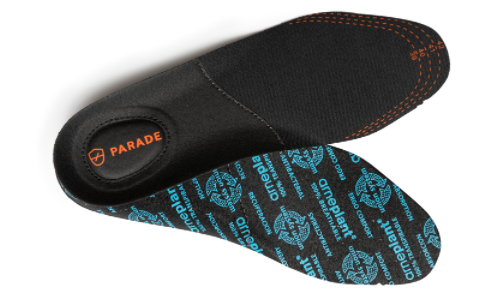Components of safety shoes
At first glance, you might think that safety shoes are just ordinary shoes. But think again. Safety shoes are made up of different parts, each more technically important than the previous one, with different functions as follows:
Let's break down all the components of safety shoes to see what each part does.

Components of safety shoes

1. Upper part
The part that covers the foot of a shoe is called the "upper." This "upper" is actually made from a variety of materials, including leather (suede, nubuck, chamois, oiled leather, etc.), microfiber, fabric, and many more.
The choice of upper components depends on the intended use of the shoe, such as water resistance, breathability, and ease of cleaning, but also on the labels and additional requirements that the shoe must meet.
1A lining
The lining is the inner part of the shoe that comes into direct contact with the wearer's foot.
This lining plays several roles: First, it helps your feet to wear shoes comfortably. Second, it is breathable and absorbs sweat. Feet are one of the parts of the body that sweat the most. Wearing safety shoes along with physical activities will increase sweating. And yes, during the day, your feet will sweat about 150 to 200 milliliters per foot. That's the equivalent of a glass of water! So, a lining with absorbent and breathable properties will help control moisture and make your feet feel more comfortable.
1B Shoe edge and tongue
The tongue is a strip that can be made of various materials. It is attached to one end. Its role is to hold the shoe on the wearer's foot and prevent the shoelaces from marking the foot. It also adds comfort to the instep as it is often padded with foam.
Stretch is when the tongue is attached on three sides and has a triangle-like shape. Stretch has several benefits: first, to prevent soil or water from entering the shoe, and second, to maintain the shape of the tongue so it doesn’t curl on the wearer’s foot.
The collar is located on the back of the foot at the top of the ankle of the shoe. It provides support and comfort as it is usually made of a soft, foamy material. The size of the collar depends on the height of the shoe shaft.
1C Tying Shoes
Our safety shoes come with a variety of lacing systems including laces, Velcro, and zippers. The purpose of these systems is to hold the foot securely and effectively prevent contaminants from entering the shoe.
Laces and Velcro allow users to customize the fit of the shoe to their preferences or foot shape.
2. Protective toe cap or protective armor
The toe cap is located at the front of the shoe. Its main function is to protect the toes from falling objects (impact) and impacts (such as being crushed by construction site equipment).
According to the EN ISO 20345 standard, regardless of the type of shoe (S1, S1P, S2, S3) or the material of the toe cap (steel, composite, aluminium, carbon, etc.), the basic requirements for toe strength are the same: it must be able to withstand an impact of at least 203 joules. The safety toe cap is a very important component of safety footwear (EN ISO 20345), which sets it apart from general work shoes without a toe cap (EN ISO 20347) or general casual shoes.
It is also worth noting that protective footwear (EN ISO 20346 standard) also has a toe cap, but it has a lower impact resistance than safety footwear (EN ISO 20345). Protective footwear has an impact resistance of 100 joules, while safety footwear has an impact resistance of 200 joules.
Protective toe caps can be made from two main types of materials:
- Protective toe cap made of metal, such as steel or aluminum.
- Non-metallic protective toe caps, such as combination protective toe caps
Each material has different properties, such as electrical conductivity or thinness.
3. Shoe lining
The insole is located inside the shoe, in direct contact with the foot. It is made of a material (such as fabric, mesh, PU foam or EVA foam) that provides a perfect fit, good support and breathability.

4. Foot insert
In safety shoes, the insert is a piece of midsole that sits in the outer sole of the shoe. Its role is to protect the sole of your foot from the risk of being stabbed or cut by the ground, especially in workplaces where there may be dry materials in the ground. Having an insert will help prevent injuries that can occur from these.
Inserts can be metallic or non-metallic.
Steel plates are often known for their high durability, but are prone to nicks and tarnishing for certain occupations that require sitting (such as plumbers or bricklayers).
Other fabric (non-metal) stab-proof materials are also recognized as more flexible and provide better heat insulation.
As a reminder, in contrast to safety shoes (EN ISO 20345), work shoes (EN ISO 20347) are not equipped with automatic puncture protection inserts (Shoe Codes 03 and 05). Furthermore, some footwear of this nature are affected by puncture, depending on their standard description.
5. Insole
The sole of safety shoes ensures comfort and stability for the wearer. The sole and upper can be assembled using various methods.
The sole can be made of one material, such as polyurethane (PU), rubber, or different densities of the same material... but it can also be multi-material. In this case, the midsole and sole of the shoe are separated.
- Midsoles provide comfort and cushioning. They are usually made of lightweight, shock-absorbing materials, such as EVA (EVA) or polyurethane (PU).
- The sole is the part of the shoe that contacts the ground. Sole properties include abrasion resistance and traction, and it is made of durable materials such as polyurethane (PU) or rubber.











